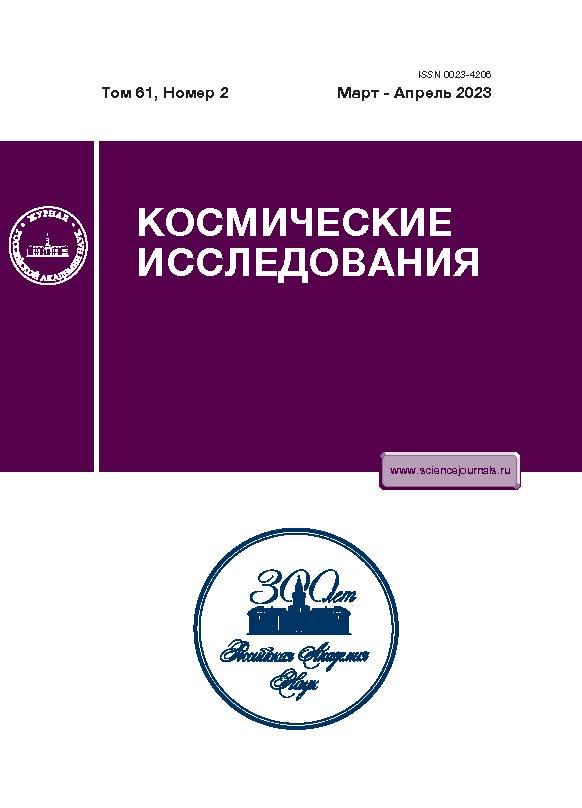Implementation of a Spacecraft Solar-Orientation Model Using a Reaction-Wheel System
- Authors: Ignatov A.I.1, Ivanov G.A.1, Kolomietz E.S.1, Martynenkova E.V.1
-
Affiliations:
- Bauman Moscow State Technical University, 105005, Moscow, Russia
- Issue: Vol 61, No 2 (2023)
- Pages: 143-156
- Section: Articles
- URL: https://rjmseer.com/0023-4206/article/view/672677
- DOI: https://doi.org/10.31857/S0023420622700017
- EDN: https://elibrary.ru/LUGGZP
- ID: 672677
Cite item
Abstract
The mode of maintaining a solar orientation of spacecraft–gyrostat in low Earth orbit for a long time has been studied. The spacecraft is close to a cylinder in shape with two fixed solar arrays. The arrays are located along the longitudinal axis of the cylinder, symmetrically with respect to it. In the solar-orientation mode, the normal to the plane of the spacecraft solar arrays is invariably directed to the Sun, and the longitudinal axis oscillates relative to the plane of the orbit. To implement the specified mode of the spacecraft motion, a system of four reaction wheels is used, the rotation axes of which are directed parallel to the lateral edges of the quadrangular pyramid. The position of the lateral edges of the pyramid relative to the coordinate system rigidly connected to the spacecraft is given by two angles, which are the parameters of the reaction-wheel system. The law of control of the gyrostatic moment is considered, which ensures the attenuation of the perturbed motion of the spacecraft in the vicinity of the position of its solar orientation and limits the accumulation of the own kinetic moment of the reaction wheels by controlling the angle of rotation of the spacecraft around the normal to the light-sensitive side of the solar arrays. The study shows that with the help of a certain choice of parameters of the reaction-wheel system, it is possible to implement the solar-orientation mode without unloading the gyrostatic moment during the entire flight time. The results of numerical simulation of the complete system of equations of the spacecraft motion in the mode of its solar orientation, taking into account the influence of gravitational and aerodynamic moments, are presented, confirming the correctness of the chosen values of the parameters.
About the authors
A. I. Ignatov
Bauman Moscow State Technical University, 105005, Moscow, Russia
Email: general_z@mail.ru
Россия, Москва
G. A. Ivanov
Bauman Moscow State Technical University, 105005, Moscow, Russia
Email: general_z@mail.ru
Россия, Москва
E. S. Kolomietz
Bauman Moscow State Technical University, 105005, Moscow, Russia
Email: general_z@mail.ru
Россия, Москва
E. V. Martynenkova
Bauman Moscow State Technical University, 105005, Moscow, Russia
Author for correspondence.
Email: general_z@mail.ru
Россия, Москва
References
- Игнатов А.И., Сазонов В.В. Оценка низкочастотных микроускорений на борту ИСЗ в режиме одноосной солнечной ориентации // Космич. исслед. 2013. Т. 51. № 5. С. 380–388. https://doi.org/10.7868/S0023420613050051 (Cosmic Research. 2013. Т. 51. № 5. С. 342–349.)
- Игнатов А.И. Стабилизация режима солнечной ориентации искусственного спутника Земли без накопления кинетического момента гиросистемы // Изв. РАН. Теория и системы управления. 2020. № 3. С. 164–176. https://doi.org/10.31857/S0002338820030063
- Игнатов А.И. Оценка низкочастотных микроускорений на борту искусственного спутника Земли в режиме солнечной ориентации // Космич. исслед. 2022. Т. 60. № 1. С. 43–56. https://doi.org/10.31857/S0023420622010046 (Cosmic Research. 2022. Т. 60. № 1. С. 38–50.)
- Бажинов И.К., Гаврилов В.П., Ястребов В.Д. и др. Навигационное обеспечение полета орбитального комплекса “Салют-6” – “Союз” – “Прогресс”. М.: Наука, 1985.
- Белецкий В.В. Движение искусственного КА относительно центра масс. М.: Наука, 1965.
- Меес Ж. Астрономические формулы для калькуляторов. М.: Мир, 1988.
- Игнатов А.И. Выбор геометрических параметров расположения системы двигателей-маховиков при управлении вращательным движением космического аппарата // Изв. РАН. Теория и системы управления. 2022. № 1. С. 124–144. https://doi.org/10.31857/S0002338822010061
- Гантмахер Ф.Р. Теория матриц. Москва, Наука. Главная редакция физ.-мат. литературы, 1988.
- Markley F.L., Reynolds R.G., Liu F.X. Maximum torque and momentum envelopes for reaction-wheel arrays // J. Guidance, Control, and Dynamics. 2010. V. 33. № 5. P. 1606–1614. https://doi.org/10.2514/1.47235
- Yoon H., Seo H.H., Choi H.-T. Optimal uses of reaction wheels in the pyramid configuration using a new minimum infinity-norm solution // Aerospace Science and Technology. 2014. V. 39. P. 109–119. https://doi.org/10.1016/j.ast.2014.09.002
- Yoon H., Seo H.H., Park Y.-W., Choi H.-T. A New Minimum Infinity-Norm Solution: with Application to Capacity Analysis of Spacecraft Reaction Wheels // American Control Conf. (ACC). 2015. P. 1241–1245.
- Стренг Г. Линейная алгебра и ее применения. М.: Мир, 1980.
Supplementary files






















